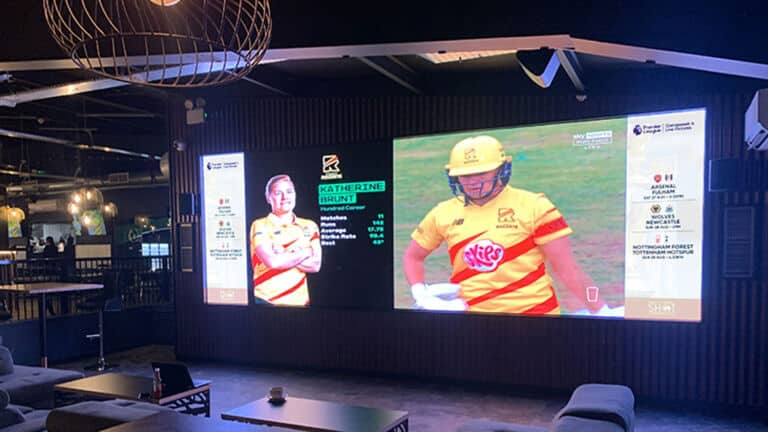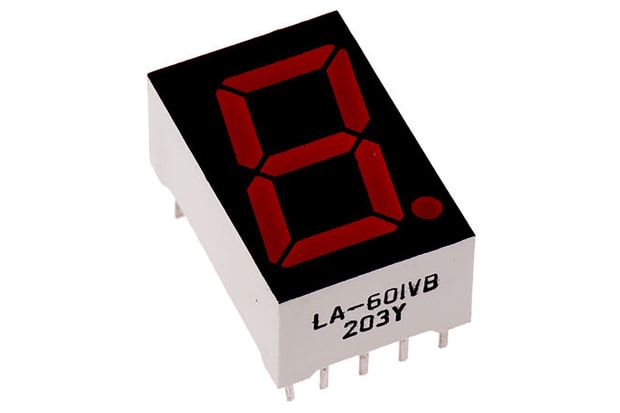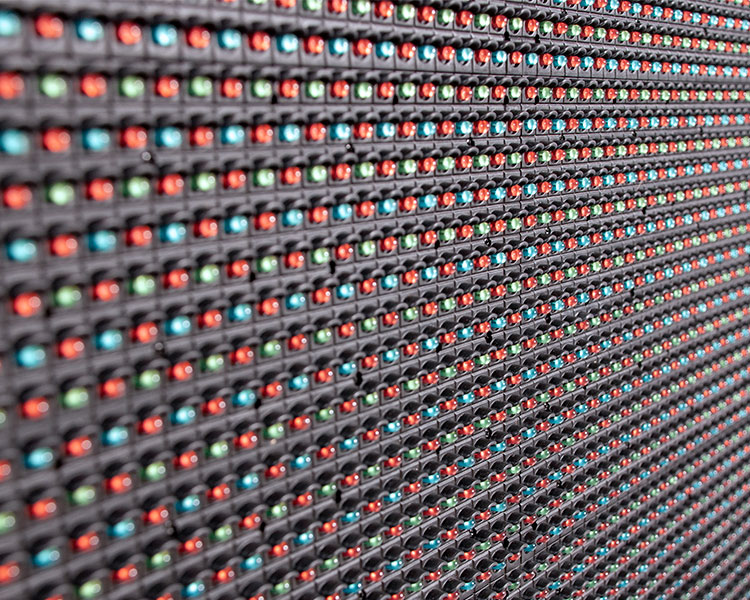Good News To Selecting Flexible Led Panels
When Looking At Led Displays, What Are The Pixel Pitch And Resolution?When looking into LED displays, resolution and pixel pitch are two important aspects to be considered. Both have a direct impact on the clarity, the detail and overall appearance provided by the display. These two aspects are essential due to a variety of reasons.
1. Image Quality
Pixel Pitch: The pixel pitch is the distance between the middle of an LED's pixel and the middle of the next. A lower pitch means that the LEDs have greater spacing, leading to a higher resolution. This is directly translated to sharper and more precise images.
Resolution: The number of pixels shown on the screen. It is typically stated in terms of width and height (e.g. 2048x1080). Higher resolutions allow for more details to be displayed and gives a fuller experience. This is crucial for large-screens, as the viewer is close to the screen.
2. Distance to view
The pixel pitch has a direct correlation to the ideal viewing distance. To prevent pixelation, displays that are seen closely such as those in exhibitions and retail stores, or indoor screens, require a lower pixel pitch (and higher resolution). In contrast, for outdoor billboards and large-scale displays viewed from a distance, a larger pixel pitch might suffice since the individual pixels aren't visible from afar.
3. Content Versatility
Displays with higher resolutions and smaller pixels are able to display different types of content. From high-definition HD video to tiny graphics and intricate text they're capable of handling a wide variety of formats. This versatility can be crucial in applications like broadcast studios, digital signage and control rooms.
4. Cost Implications
A lower pixel pitch might provide better image quality, however it can also increase the price of the display. Producing screens with a high resolution will cost more due to the quantity of LEDs used. In order to find the perfect balance between high resolution and budget it is important to consider the needs as well as the distance to the screen.
5. Application Specificity
The importance of pixel pitch and resolution will vary based on the application:
Indoor Displays - Often smaller pixels are needed (e.g. between 1.2mm between 1.2mm and 2.5mm) for indoor displays to keep high resolutions for close-up viewing.
Outdoor Displays: May have larger pixel pitches (e.g. 4mm to 10mm) because they're viewed from greater distances, where the resolution is less critical.
6. Longevity of the product and its upgradeability
As technology for display advancements the pixel pitch decreases and allowing greater resolutions even in smaller areas. By investing today in a screen that has ideal pixel pitches that are more efficient and useful for a longer time. This means that you don't have to replace screens often.
Conclusion:
Pixel pitch and display resolution are key factors that affect the performance of LCD displays. This is particularly true when it comes to watching experience and content flexibility. To choose the ideal LED display for your project budget, size, and market, you must carefully consider all of these factors. View the recommended creative led displays for website advice including led display screen rental, led board, led display screen, transparent led screen display, transparent screen monitor, led rental screen, outdoor led screen, led display screen rental, led light board, advertising displays and more.

How Important Is The Angle Of View When You Are Researching Led Displays?
It is important to keep in mind the angle of view when searching for LED displays. Especially for applications in which it is viewed at various angles and from different locations. Here's why viewing angle is important:
1. Uniform Image Quality
Definition: The LCD display's viewing angle refers to the widest angle at which an acceptable display performance can be observed (normally in terms or intensity and color consistency). The viewing angle is determined in both vertical and horizontal directions.
Important: Wider viewing angles ensure the same image quality regardless of how the user is positioned in relation to the display. This implies that the brightness and colors will not change when viewing above or below or from the sides.
2. Experience of Audience
The impact of large venues. Large spaces, like stadiums concert halls as well as conference centres, audience members are spread out over an extensive area. Displays with a narrow view angle could result in poor visibility or a degraded quality image for viewers who sit at the right angles.
Application Broad viewing angles are essential for large events or installations in which the crowd will be situated in an arc around the display. This will ensure that everyone gets a clear image of the display.
3. Suitability in Public Spaces
Public Displays For settings such as shopping malls, transportation hubs or other outdoor advertising venues viewing angles are vital since people are viewing the display from all angles. A small viewing space would restrict the capacity for the display to be engaging and attract passersby.
Application Digital signage in public places will benefit from large viewing angle to increase the reach of the display and help make the content more noticeable and appealing.
4. Content Consistency
Uniformity in Brightness and Color - Displays that aren't uniform in color or brightness viewing angle could show color shifting, or a decrease in brightness when viewed off-center. This issue can be especially difficult for content that is brand-related, where color accuracy is crucial.
Application: In settings where brand image and uniformity of color are crucial, such as corporate or retail environments, a wide viewing angle ensures that the display maintains its desired appearance from any viewing position.
5. Installation Flexibility
Versatility when installing: A display with a large viewing area offers greater flexibility. As an example, it offers more innovative placement options like wrapping the display around columns or positioning in areas where people can see it from different directions.
Application: Wide viewing angles are great for LED displays in architectural or creative applications like those that are found in galleries, museums, or immersive experiences. They permit more innovative designs, without compromising on the experience of the user.
6. Renting and staging Stages and renting
Event Settings Event Settings: For staging and rental where displays are set up in different settings and locations and in various locations, having a wide perspective is necessary to ensure that the display can function effectively in any setting and provide consistent quality, regardless of the audience's position.
Application for trade shows that draw crowds that move around, or for concerts where people are viewing the show from various locations A wide-angle view will ensure that everyone can see the content clearly.
7. Impact on ROI
Maximizing Visibility - A display that offers a wide angle viewing can engage a larger audience, which will increase the impact and the ROI (return on investment). This is especially important for informational or advertising screens where maximizing visibility is key to achieving desired outcomes.
Application in commercial installations, making sure the display is viewable from different angles can improve the level of engagement and, in turn, the quality of the information being displayed.
Conclusion:
The angle of view directly influences the display's visibility, efficiency and consistency. This is especially the case in environments that have large audiences spread out. The display may also be seen by different individuals from different positions. Wide viewing angles are important when researching LED displays to ensure the display will meet the requirements of your project and offer a quality viewing experience for all. See the most popular led rental screen for website examples including led in the wall, led display rental, outdoor led screen, led panel transparent, digital display, led screen rental, flexible led display, video wall church, led screen transparent, transparent display monitor and more.

When It Comes To Led Displays, How Important Is Compatibility? Content Management System (Cms).
It is crucial to take into account the compatibility and content management system (CMS) when looking at LED displays. This is especially crucial when it comes to applications that have frequent updates, where many locations must be controlled as well as the integration of different digital systems. CMS compatibility and content management are essential for LED displays.
1. Content Management Made Easy
CMS Features A robust CMS allows for easy creation, scheduling, and management of content on LED displays. It offers a user-friendly interface for uploading, organising playlists, and scheduling time for display, making it easier to ensure that your content is always up-to-date.
Importance: A powerful CMS streamlines operations for businesses that need to update their content regularly, such as stores, advertising networks, and event venues. This can reduce the time and effort required to manage displays.
2. Remote Control and Flexibility
Remote Management Remote Management CMS that is well-designed will allow you to update content from any location. This is essential for companies that have multiple displays across different websites.
Remote management is vital in situations like digital signage networks, corporate communication or educational institutions where displays are scattered across multiple places. This allows for consistent and timely delivery of content.
3. Scheduling Automation
Content Scheduling. A CMS that has ability to schedule content lets you plan content ahead and ensures that the correct messages are displayed at just the right timing. This is useful for targeting specific audiences at certain time of the day or at particular events.
Automated updating of content saves time, and guarantees that the content is always updated. This is especially useful in dynamic environments such as airports. Hotels, as well as large locations.
Application: For companies that need to manage content round the clock, such as news broadcasters, transport hubs, or large retailers, the scheduling and automated capabilities in the CMS are crucial to ensure efficient operations.
4. Compatible with the existing systems
Integration: Compatibility with existing IT infrastructure, media players, and software systems is vital for ensuring seamless operation. A CMS which can be integrated with other digital tools and platforms like content creation software tools for analytics, customer relationship management (CRM) systems, provides significant value.
Application: If digital signage is required to integrate with other systems, such as smart cities with integrated customer data or large corporate networks that have data integration the compatibility of these systems is vital for smooth operation.
5. Scalability
Future Expansion A scalable CMS allows you to expand along with your business. It is a great tool to build new displays, expand into other locations, and manage larger content databases.
Application: Businesses who plan to expand such as hospitality chains, retail chains or multinational corporations, can make use of a CMS that is scalable so that their digital signage infrastructure will be capable of growing along with them.
6. Variety of Content and Support
Content Types. The CMS should provide a wide range of content formats including images, videos as well as text and interactive content. This lets you create interesting and varied content that is suited to your audience.
Application: When diversity of content is crucial, like in entertainment venues, educational institutions, or advertising network, the capability to support different content types will guarantee that the display will fulfill all the requirements of content.
7. User Access and Security
Role-Based Control: A CMS with role-based control offers different levels of access for various users. It is essential to ensure that only authorized personnel are able to modify the settings.
Security Secure: A CMS that is secure is essential to safeguard users from access that is not authorized. Unauthorized access can lead to dangerous or harmful information to be shown.
Access to security and access based on role are important for organizations like large corporations or government agencies who manage the content of multiple users.
8. Real-time Content Updates
Live Content Integration: The ability to change content in real-time or incorporate live feeds (such as news, social media or live event coverage) can be crucial for specific applications. This is especially important for events, broadcasts and other scenarios that require immediate content.
Application: In venues like sporting arenas, live events, and news channels The real-time update of content guarantees that the viewers receive the most up-to-date information. It also enhances relevance and impact.
9. Analytics and Reporting
Performance Metrics. A quality CMS must provide analysis and reporting tools that let you monitor the performance of your content. Understanding how viewers engage with content and its effectiveness is crucial to optimize the content for the future and ensuring that the display designs meet their goals.
Application: For companies who rely on data to make educated choices, such as retailers, advertisers, or public systems of information, analytics and report capabilities are crucial to understanding and optimizing the effectiveness and impact of digital signage.
Conclusion:
Effective LED display strategies need an efficient CMS that is compatible and strong. They allow for effective managing content and seamless integration with your existing system. They also allow for scaling, flexibility, and a variety of applications. If you are researching alternatives for LED displays, choose a CMS that is aligned with the operational requirements. These features are not only likely to improve the performance, but they will increase the return on investment. Check out the recommended flexible advertising boards for site recommendations including led panel transparent, flexible led display, display screen led, led display transparent, display led outdoor, led in the wall, flexible led screen display, tv the wall, led light board, led video wall and more.
